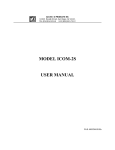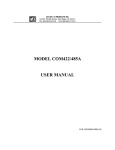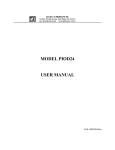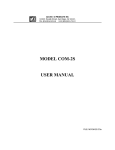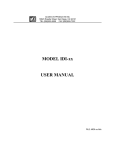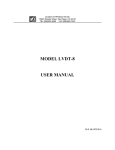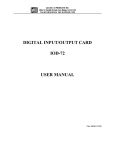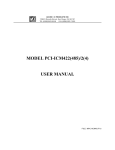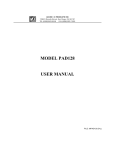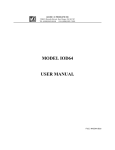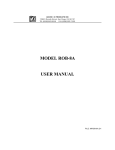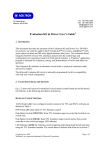Download DA_06A Manual - ACCES I/O Products, Inc.
Transcript
ACCES I/O PRODUCTS INC 10623 Roselle Street, San Diego, CA 92121 TEL (858)550-9559 FAX (858)550-7322 MODEL D/A-06A USER MANUAL FILE: MDA06A.E2b Notice The information in this document is provided for reference only. ACCES does not assume any liability arising out of the application or use of the information or products described herein. This document may contain or reference information and products protected by copyrights or patents and does not convey any license under the patent rights of ACCES, nor the rights of others. IBM PC, PC/XT, and PC/AT are registered trademarks of the International Business Machines Corporation. Printed in USA. Copyright 1995 by ACCES I/O Products Inc, 10623 Roselle Street, San Diego, CA 92121. All rights reserved. Pageiii Warranty Prior to shipment, ACCES equipment is thoroughly inspected and tested to applicable specifications. However, should equipment failure occur, ACCES assures its customers that prompt service and support will be available. All equipment originally manufactured by ACCES which is found to be defective will be repaired or replaced subject to the following considerations. Terms and Conditions If a unit is suspected of failure, contact ACCES' Customer Service department. Be prepared to give the unit model number, serial number, and a description of the failure symptom(s). We may suggest some simple tests to confirm the failure. We will assign a Return Material Authorization (RMA) number which must appear on the outer label of the return package. All units/components should be properly packed for handling and returned with freight prepaid to the ACCES designated Service Center, and will be returned to the customer's/user's site freight prepaid and invoiced. Coverage First Three Years: Returned unit/part will be repaired and/or replaced at ACCES option with no charge for labor or parts not excluded by warranty. Warranty commences with equipment shipment. Following Years: Throughout your equipment's lifetime, ACCES stands ready to provide on-site or in-plant service at reasonable rates similar to those of other manufacturers in the industry. Equipment Not Manufactured by ACCES Equipment provided but not manufactured by ACCES is warranted and will be repaired according to the terms and conditions of the respective equipment manufacturer's warranty. General Under this Warranty, liability of ACCES is limited to replacing, repairing or issuing credit (at ACCES discretion) for any products which are proved to be defective during the warranty period. In no case is ACCES liable for consequential or special damage arriving from use or misuse of our product. The customer is responsible for all charges caused by modifications or additions to ACCES equipment not approved in writing by ACCES or, if in ACCES opinion the equipment has been subjected to abnormal use. "Abnormal use" for purposes of this warranty is defined as any use to which the equipment is exposed other than that use specified or intended as evidenced by purchase or sales representation. Other than the above, no other warranty, expressed or implied, shall apply to any and all such equipment furnished or sold by ACCES. Page iv Table of Contents Notice . . . . . . . . . . . . . . . . . . . . . . . . . . . . . . . . . . . . . . . . . . . . . . . . . . . . . . . . . . . . . . iii Warranty . . . . . . . . . . . . . . . . . . . . . . . . . . . . . . . . . . . . . . . . . . . . . . . . . . . . . . . . . . . ii Chapter 1: Introduction . . . . . . . . . . . . . . . . . . . . . . . . . . . . . . . . . . . . . . . . . . . . . . 1-1 Specifications . . . . . . . . . . . . . . . . . . . . . . . . . . . . . . . . . . . . . . . . . . . . . . . . . . . . . . . . . 1-2 Chapter 2: Installation . . . . . . . . . . . . . . . . . . . . . . . . . . . . . . . . . . . . . . . . . . . . . . 2-1 CD Installation . . . . . . . . . . . . . . . . . . . . . . . . . . . . . . . . . . . . . . . . . . . . . . . . . . . . . . . . . 3.5-Inch Diskette Installation . . . . . . . . . . . . . . . . . . . . . . . . . . . . . . . . . . . . . . . . . . . . . . Directories Created on the Hard Disk . . . . . . . . . . . . . . . . . . . . . . . . . . . . . . . . . . . . . . . Installing the Card . . . . . . . . . . . . . . . . . . . . . . . . . . . . . . . . . . . . . . . . . . . . . . . . . . . . . . 2-1 2-1 2-2 2-4 Chapter 3: Option Selection . . . . . . . . . . . . . . . . . . . . . . . . . . . . . . . . . . . . . . . . . . 3-1 Analog Output Mode, Voltage or Current . . . . . . . . . . . . . . . . . . . . . . . . . . . . . . . . . . . . 3-1 Analog Output Update Mode . . . . . . . . . . . . . . . . . . . . . . . . . . . . . . . . . . . . . . . . . . . . . 3-3 Chapter 4: Address Selection . . . . . . . . . . . . . . . . . . . . . . . . . . . . . . . . . . . . . . . . . 4-1 Chapter 5: Programming . . . . . . . . . . . . . . . . . . . . . . . . . . . . . . . . . . . . . . . . . . . . . 5-1 Chapter 6: Software . . . . . . . . . . . . . . . . . . . . . . . . . . . . . . . . . . . . . . . . . . . . . . . . . 6-1 Setup Program . . . . . . . . . . . . . . . . . . . . . . . . . . . . . . . . . . . . . . . . . . . . . . . . . . . . . . . . 6-1 Programming the D/A-06A . . . . . . . . . . . . . . . . . . . . . . . . . . . . . . . . . . . . . . . . . . . . . . . 6-1 Chapter 7: Calibration . . . . . . . . . . . . . . . . . . . . . . . . . . . . . . . . . . . . . . . . . . . . . . . 7-1 Chapter 8: Connector Pin Assignments . . . . . . . . . . . . . . . . . . . . . . . . . . . . . . . . 8-1 Appendix A: PPI Data Sheets . . . . . . . . . . . . . . . . . . . . . . . . . . . . . . . . . . . . . . . A-1 Page v List of Figures Figure 1-1: D/A-06A Block Diagram . . . . . . . . . . . . . . . . . . . . . . . . . . . . . . . . . . . . . . . . . . . 1-4 Figure 3-2: D/A-06A Option Selection Map . . . . . . . . . . . . . . . . . . . . . . . . . . . . . . . . . . . . . 3-4 List of Tables Table 3-1: Table 3-2: Table 4-1: Table 4-2: Table 4-3: Table 5-1: Table 8-1: Page vi Selecting Voltage Range . . . . . . . . . . . . . . . . . . . . . . . . . . . . . . . . . . . . . . . . . . Selecting Current Range . . . . . . . . . . . . . . . . . . . . . . . . . . . . . . . . . . . . . . . . . . Standard Address Assignments for PC and PC/XT Computers . . . . . . . . . . . . . Standard Address Assignments for 286/386/486 Computers . . . . . . . . . . . . . . . Example of Address Selection . . . . . . . . . . . . . . . . . . . . . . . . . . . . . . . . . . . . . . D/A-06A I/O Address Map . . . . . . . . . . . . . . . . . . . . . . . . . . . . . . . . . . . . . . . . . Connector Pin Assignments . . . . . . . . . . . . . . . . . . . . . . . . . . . . . . . . . . . . . . . . 3-1 3-2 4-1 4-2 4-3 5-1 8-1 Chapter 1: Introduction The D/A-06A is a full-size card that can be installed in long slots of PC/XT/AT class computers. It contains six digital-to-analog converters (DAC) and twenty-four programmable digital I/O channels. Each analog output channel can be independently configured for voltage ranges of: 0V to +5V 0V to +10V -2.5V to +2.5V -5V to +5V -10V to +10V Or for current ranges of: 1mA to 5mA 4mA to 20mA With the addition of one resistor per channel the analog outputs can also be configured for a current range of 0mA to 50mA. All analog output channels have double-buffered inputs for single-step update and each is addressed at its own I/O location. Analog output channels can be user-selected to provide simultaneous updating by either software or external signal. That updating is user-assignable in pairs of channels or all DAC channels can be updated simultaneously. Digital I/O channels are provided from a type 8255 Programmable Peripheral Interface chip (PPI). The 8255 PPI is a general purpose programmable I/O device. It provides 24 bits of digital I/O and may be programmed for three major modes of operation. In MODE 0 each group of 24 I/O pins may be programmed to be input or output in sets of eight for ports A and B and in sets of four for port C. In MODE 1, each group may be programmed to have eight lines of input or output. Of the remaining four pins, three are used for handshaking and interrupt control signals. In MODE 2, eight lines are used for bi-directional bus and five lines are used for handshaking. A detailed description of the 8255 PPI is contained in Appendix A. Manual MDA06A.E2b Page 1-1 D/A-06A Manual Specifications Analog Outputs • • • • Resolution: 12 bits (0 to 4095 decimal) Channels: Six Voltage Output Ranges at 5mA max.: 0.0 to 5.0 VDC 0.0 to 10.0 VDC -2.5 to +2.5 VDC -5.0 to +5.0 VDC -10.0 to +10.0 VDC Current Output Ranges with excitation voltage (8 - 36) VDC: 1 to 5 mA 4 to 20 mA 0 to 50 mA * *:Addition of one 167 ohm resistor per channel is required. See Chapter 3, Option Selection. Digital to Analog Converter • • • • • • • AD-7537 monolithic chip, double buffered, right justified. Data Format: Right-justified, two bytes (8LSB's and 4MSB's). Relative Accuracy: +/- 1 LSB (includes nonlinearity). Monotonicity: Guaranteed over operating temperature range. Settling time: 4 usec to 0.01% for full scale step input. Offset Temperature Drift: +/- 1 ppm/ °C. typ. +/- 3 ppm/ °C. max. Gain Temperature Drift: +/- 1 ppm/ °C. typ. +/- 5 ppm/ °C. max. Page 1-2 Manual MDA06A.E2b Digital Inputs/Outputs • • • • 24 programmable digital input/ output lines. (Ports A, B, C lo, and C hi). 8255 PPI Controller. All modes supported. Inputs TTL, DTL, CMOS compatible: Logic Low: -0.5V to +0.8V. Logic High: +2.0V to +5.0V. Load Current: 10 uA. Outputs TTL, DTL, CMOS compatible: Logic Low: 0.45V max. at 1.7mA sink current. Logic High: 2.4V min. at -200uA source current. 1.5V min. at -1mA source current (Darlington drive not available from Port A). Power Requirements • • • +5 VDC at 500mA max. +12 VDC at 70mA max. -12 VDC at 60mA max. Environmental • • • • Operating Temperature: 0 °C. to +60 °C. Storage Temperature: -20 °C. to +85 °C. Humidity: 5% to 95% non condensing. Size: 13.375 inches. Install in a full-size slot. Manual MDA06A.E2b Page 1-3 D/A-06A Manual Figure 1-1: D/A-06A Block Diagram Page 1-4 Manual MDA06A.E2b Chapter 2: Installation The software provided with this card is contained on either one CD or multiple diskettes and must be installed onto your hard disk prior to use. To do this, perform the following steps as appropriate for your software format and operating system. Substitute the appropriate drive letter for your CD-ROM or disk drive where you see d: or a: respectively in the examples below. CD Installation DOS/WIN3.x 1. 2. 3. 4. Place the CD into your CD-ROM drive. Type d:K to change the active drive to the CD-ROM drive. Type installK to run the install program. Follow the on-screen prompts to install the software for this card. WIN95/98/NT a. b. c. Place the CD into your CD-ROM drive. The CD should automatically run the install program after 30 seconds. If the install program does not run, click START | RUN and type d:install, click OK or press K. Follow the on-screen prompts to install the software for this card. 3.5-Inch Diskette Installation As with any software package, you should make backup copies for everyday use and store your original master diskettes in a safe location. The easiest way to make a backup copy is to use the DOS DISKCOPY utility. In a single-drive system, the command is: diskcopy a: a:K You will need to swap disks as requested by the system. In a two-disk system, the command is: diskcopy a: b:K This will copy the contents of the master disk in drive A to the backup disk in drive B. Manual MDA06A.E2b Page 2-1 D/A-06A Manual To copy the files on the master diskette to your hard disk, perform the following steps. 1. Place the master diskette into a floppy drive. 2. Change the active drive to the drive that has the diskette installed. For example, if the diskette is in drive A, type a:K. 3. Type installK and follow the on-screen prompts. Directories Created on the Hard Disk The installation process will create several directories on your hard disk. If you accept the installation defaults, the following structure will exist. [CARDNAME] Root or base directory containing the SETUP.EXE setup program used to help you configure jumpers and calibrate the card. DOS\PSAMPLES: DOS\CSAMPLES: Win32\language: A subdirectory of [CARDNAME] that contains Pascal samples. A subdirectory of [CARDNAME] that contains "C" samples. Subdirectories containing samples for Win95/98 and NT. WinRisc.exe A Windows dumb-terminal type communication program designed for RS422/485 operation. Used primarily with Remote Data Acquisition Pods and our RS422/485 serial communication product line. Can be used to say hello to an installed modem. ACCES32 This directory contains the Windows 95/98/NT driver used to provide access to the hardware registers when writing 32-bit Windows software. Several samples are provided in a variety of languages to demonstrate how to use this driver. The DLL provides four functions (InPortB, OutPortB, InPort, and OutPort) to access the hardware. This directory also contains the device driver for Windows NT, ACCESNT.SYS. This device driver provides register-level hardware access in Windows NT. Two methods of using the driver are available, through ACCES32.DLL (recommended) and through the DeviceIOControl handles provided by ACCESNT.SYS (slightly faster). Page 2-2 Manual MDA06A.E2b SAMPLES Samples for using ACCES32.DLL are provided in this directory. Using this DLL not only makes the hardware programming easier (MUCH easier), but also one source file can be used for both Windows 95/98 and WindowsNT. One executable can run under both operating systems and still have full access to the hardware registers. The DLL is used exactly like any other DLL, so it is compatible with any language capable of using 32-bit DLLs. Consult the manuals provided with your language's compiler for information on using DLLs in your specific environment. VBACCES This directory contains sixteen-bit DLL drivers for use with VisualBASIC 3.0 and Windows 3.1 only. These drivers provide four functions, similar to the ACCES32.DLL. However, this DLL is only compatible with 16-bit executables. Migration from 16-bit to 32-bit is simplified because of the similarity between VBACCES and ACCES32. PCI This directory contains PCI-bus specific programs and information. If you are not using a PCI card, this directory will not be installed. SOURCE A utility program is provided with source code you can use to determine allocated resources at run-time from your own programs in DOS. PCIFind.exe A utility for DOS and Windows to determine what base addresses and IRQs are allocated to installed PCI cards. This program runs two versions, depending on the operating system. Windows 95/98/NT displays a GUI interface, and modifies the registry. When run from DOS or Windows3.x, a text interface is used. For information about the format of the registry key, consult the card-specific samples provided with the hardware. In Windows NT, NTioPCI.SYS runs each time the computer is booted, thereby refreshing the registry as PCI hardware is added or removed. In Windows 95/98/NT PCIFind.EXE places itself in the boot-sequence of the OS to refresh the registry on each power-up. This program also provides some COM configuration when used with PCI COM ports. Specifically, it will configure compatible COM cards for IRQ sharing and multiple port issues. WIN32IRQ This directory provides a generic interface for IRQ handling in Windows 95/98/NT. Source code is provided for the driver, greatly simplifying the creation of custom drivers for specific needs. Samples are provided to demonstrate the use of the generic driver. Note that the use of IRQs in near-real-time data acquisition programs requires multi-threaded application programming techniques and must be considered an intermediate to advanced programming topic. Delphi, C++ Builder, and Visual C++ samples are provided. Manual MDA06A.E2b Page 2-3 D/A-06A Manual Findbase.exe DOS utility to determine an available base address for ISA bus , non-Plug-n-Play cards. Run this program once, before the hardware is installed in the computer, to determine an available address to give the card. Once the address has been determined, run the setup program provided with the hardware to see instructions on setting the address switch and various option selections. Poly.exe A generic utility to convert a table of data into an nth order polynomial. Useful for calculating linearization polynomial coefficients for thermocouples and other non-linear sensors. Risc.bat A batch file demonstrating the command line parameters of RISCTerm.exe. RISCTerm.exe A dumb-terminal type communication program designed for RS422/485 operation. Used primarily with Remote Data Acquisition Pods and our RS422/485 serial communication product line. Can be used to say hello to an installed modem. RISCTerm stands for Really Incredibly Simple Communications TERMinal. Installing the Card Before carefully read the chapters on Address Selection and Option Selection of this manual and configure the card according to your requirements. Use the FINDBASE program provided with the card to select the base address for the card. Use the program called SETUP to select other options such as ranges, update mode, etc. Be especially careful with address selection. If the addresses of two installed functions overlap, you will experience unpredictable computer behavior. To Install the Card 1. 2. 3. 4. 5. 6. 7. 8. Remove power from the computer. Remove the computer cover. Remove blank I/O backplate. Install jumpers for selected options. See Option Selection, Chapter 3. Select the base address on the card. See Address Selection, Chapter 4. Install the card in an I/O expansion slot. Important: Make sure that the card mounting bracket is properly screwed into place and that there is a positive chassis ground. Inspect for proper fit of the card and cables and tighten screws. Replace the computer cover. Page 2-4 Manual MDA06A.E2b To ensure that there is minimum susceptibility to EMI and minimum radiation, it is important that there be a positive chassis ground. Also, proper EMI cabling techniques (cable connect to chassis ground at the I/O connector, twisted-pair wiring, and, in extreme cases, ferrite level of EMI protection) must be used for input/output wiring. CE-marked versions of D/A-06A meet the requirements of EN50081-1:1992 (Emissions), EN50082-1:1992 (Immunity), and EN60950:1992 (Safety). Manual MDA06A.E2b Page 2-5 D/A-06A Manual Page 2-6 Manual MDA06A.E2b Chapter 3: Option Selection Refer to the Block Diagram and Option Selection Map when reading this section. Card operation is determined by jumper installation and switch settings as described in the following paragraphs. Analog Output Mode, Voltage or Current Each analog output channel can be configured as a voltage or current output by installation of jumpers in locations marked V0 through V5, or I0 through I5. Output Ranges The output ranges are individually selected for each analog output channel 0 through 5 individually by corresponding switches S0 through S5. The following tables list switch settings for the desired output range. Analog Output Voltage Range Switch Position 1 2 3 4 5 6 0 to 5V ON OFF OFF OFF ON OFF 0 to 10V OFF ON OFF OFF ON OFF -2.5 to +2.5V ON OFF OFF ON ON OFF -5 to +5V ON OFF OFF ON OFF OFF -10 to +10V OFF ON OFF ON OFF OFF Table 3-1: Selecting Voltage Range Jumper in "V" Position Manual MDA06A.E2b Page 3-1 D/A-06A Manual Analog Output Current Range Switch Position 1 2 3 4 5 6 1-5 mA ON OFF ON OFF ON OFF 4-20 mA ON OFF ON OFF ON ON 0-50 mA* ON OFF OFF OFF ON ON *Signifies option requiring addition of one 118 ohm resistor per channel: Table 3-2: Selecting Current Range Add R7a for channel AO0; Add R17a for channel AO1; Add R27a for channel AO2; Add R37a for channel AO3 Add R47a for channel AO4 Add R57a for channel AO5 Jumper in "I" Position * Excitation Voltage up to 60V is OK on low current ranges. Minimum voltage of 8V must be maintained for correct operation. Caution Do not connect current loops to a DAC that is set to voltage mode. The loop supply can cause irreversible damage to the DAC. Page 3-2 Manual MDA06A.E2b Analog Output Update Mode The analog-output update mode is selected by six-position DIP switch S6. Labels printed alongside the switch facilitate selection. Switches are enabled when placed in the ON position. Three analog-output update modes are available: (a) Individual update of each channel upon high-byte Write, (b) Simultaneous update of all selected channels upon Read of any digital-to-analog converter address, and (c) Simultaneous update of all selected channels upon receipt of an external signal. EX1, SM1 Control analog output channels A0 and A1; EX2, SM2 Control analog output channels A2 and A3; EX3, SM3 Control analog output channels A4 and A5; SM Software-directed simultaneous-update mode: update happens on any analog output address read. EX Update on external pulse or on a low transition. If this update mode is selected, the external signal should be wired to the output connector pins 25, 24, and 23. These pins are allocated to Digital I/O port bits C4,5,6 and will be shared in this mode, which implies that 8255 PPI port C HI should be programmed either as an input or disabled. The external update can be disabled or enabled by three additional digital I/O lines allocated to port C bits 0,1, and 2. These lines might be controlled externally, or through the 8255 PPI if port C HI is selected as an output. NONE Manual MDA06A.E2b If switches are de-selected, update will happen automatically on second (high) byte Write to the digital-to-analog converter. Page 3-3 D/A-06A Manual Figure 3-2: D/A-06A Option Selection Map Page 3-4 Manual MDA06A.E2b Chapter 4: Address Selection Refer to Item 1, "Set Board Address" on the D/A-06A card Setup program provided. The card requires 16 consecutive address locations in I/O space. The starting, or base, address can be selected anywhere within the I/O address range 100-3F0 hex (except 1F0 through 1F8) for AT's and 200 through 3F0 for XT's, providing that the address does not overlap with other functions. If in doubt, refer to the Tables below for a list of standard address assignments. The Base Address Locator program FINDBASE provided on CD will assist you in selecting the base address that will avoid this conflict Hex Range 000-00F 020-021 040-043 060-063 080-083 0AX 0CX 0EX 100-1FF 200-20F 210-217 220-24F 278-27F 2F0-2F7 2F8-2FF 300-31F 320-32F 378-37F 380-38C** 380-389** 3A0-3A9 3B0-3BF 3C0-3CF 3D0-3DF 3E0-3E7 3F0-3F7 3F8-3FF Usage DMA Chip 8237A-5 Interrupt 8259A Timer 8253-5 PPI 8255A-5 DMA Page Register NMI Mask Register Reserved Reserved Not Usable Game Control Expansion Unit Reserved Reserved Reserved Asynchronous Comm. (Secondary) Prototype Card Fixed Disk Printer SDLC Communications Binary Synchronous Comm. (Secondary) Binary Synchronous Comm. (Primary) IBM Monochrome Display/Printer Reserved Color/Graphics Reserved Diskette Asynchronous Comm. (Primary) ** These options can not be used together - addresses overlap Table 4-1: Standard Address Assignments for PC and PC/XT Computers Manual MDA06A.E2b Page 4-1 D/A-06A Manual Hex Range 000-01F 020-03F 040-05F 060-06F 070-07F 080-09F 0A0-0BF 0C0-0DF 0F0 0F1 0F8-0FF 1F0-1F8 200-207 278-27F 2F8-2FF 300-31F 360-36F 378-37F 380-38F 3A0-3AF 3B0-3BF 3C0-3CE 3D0-3DF 3F0-3F7 3F8-3FF Usage DMA Controller 1 INT Controller 1, Master Timer 8042 (Keyboard) Real Time Clock, NMI Mask DMA Page Register INT Controller 2 DMA Controller 2 Clear Math Coprocessor Busy Reset Coprocessor Arithmetic Processor Fixed Disk Game I/O Parallel Printer Port 2 Asynchronous Comm'n (Secondary) Prototype Card Reserved Parallel Printer Port 1 SDLC or Binary Synchronous Comm'n 2 Binary Synchronous Comm'n 1 Monochrome Display/Printer Local Area Network Color/Graphic Monitor Floppy Diskette Controller Asynchronous Comm'n (Primary) Table 4-2: Standard Address Assignments for 286/386/486 Computers The base address is set by a DIP switch which controls address bits A4 through A9. In order to select the base address, convert the desired address to binary. Then for each "1" of the binary address, set the corresponding DIP switch to OFF, and for each "0" of the binary address set the corresponding switch to ON. For example, to program a base address of hex 300, DIP switches A9 and A8 are set to the "OFF" position, while switches A7 through A4 are set to the "ON" position. The following example illustrates this process in detail: In this case, switch selection corresponds to binary 10 1101 xxxx (or hex 2D0). The "xxxx" represents address lines A3, A2, A1, and A0 used on the card to select individual registers. See Chapter 5, Programming. Page 4-2 Manual MDA06A.E2b Address Line Controlled A9 A8 A7 A6 A5 A4 Switch Label A9 A8 A7 A6 A5 A4 OFF ON OFF OFF ON OFF Binary Representation 1 0 1 1 0 1 Conversion Factors 2 1 8 4 2 1 Setup Hex Representation 2 D Table 4-3: Example of Address Selection Review the Address Selection Reference Table carefully before selecting card address. If the addresses of two installed functions overlap, you will experience unpredictable computer behavior. Manual MDA06A.E2b Page 4-3 D/A-06A Manual Page 4-4 Manual MDA06A.E2b Chapter 5: Programming The D/A-06A card uses 16 consecutive I/O addresses. The I/O address map is as follows: Address Write Read Base Address AO #0 Low Byte** Simultaneous Update* Base Address +1 AO #0 High Byte** Simultaneous Update* Base Address +2 AO #1 Low Byte** Simultaneous Update* Base Address +3 AO #1 High Byte** Simultaneous Update* Base Address +4 AO #2 Low Byte** Simultaneous Update* Base Address +5 AO #2 High Byte** Simultaneous Update* Base Address +6 AO #3 Low Byte** Simultaneous Update* Base Address +7 AO #3 High Byte** Simultaneous Update* Base Address +8 AO #4 Low Byte** Simultaneous Update* Base Address +9 AO #4 High Byte** Simultaneous Update* Base Address +10 AO #5 Low Byte ** Simultaneous Update* Base Address +11 AO #5 High Byte** Simultaneous Update* Base Address +12 Dig. I/O Port A Dig. I/O Port A Base Address +13 Dig. I/O Port B Dig. I/O Port B Base Address +14 Dig. I/O Port C Dig. I/O Port C Base Address +15 Dig. I/O Control*** Illegal Table 5-1: D/A-06A I/O Address Map * Analog output pairs selected by Analog Output Update switch will be simultaneously updated. See Chapter 3, Option Selection - Analog Outputs Update. ** Data are written to the digital to analog converter in right-justified format; i.e., *** The Digital I/O Control Register is used to select the MODE of operation and to configure the 8255 PPI ports A, B, C HI and C LO. Manual MDA06A.E2b Page 5-1 D/A-06A Manual BIT D7 D6 D5 D4 D3 D2 D1 D0 Low B5 B6 B7 B8 B9 B10 B11 B12 High X X X X B1 B2 B3 B4 For UNIPOLAR ranges: 0000 0000 0000 = ZERO 1000 0000 0000 = 1/2 SCALE 1111 1111 1111 = FULL SCALE | | MSB (or B1) <---- | |----> LSB (or B12) For BIPOLAR ranges: 0000 0000 0000 = - FULL SCALE 1000 0000 0000 = ZERO 1111 1111 1111 = + FULL SCALE | | MSB (or B1) <---- | |----> LSB (or B12) D7 D6, D5 D4D3D2D1D0- Mode set flag Mode selection: Port A: Port C upper: Mode selection: Port B: Port C lower: 00 = Mode 0, 01 = Mode 1, 1X = Mode 2 1 = input, 0 = output 1 = input, 0 = output 1 = Mode 1, 0 = Mode 0 1 = input, 0 = output 1 = input, 0 = output For details of 8255 PPI operation, see Appendix A. Page 5-2 Manual MDA06A.E2b Chapter 6: Software The CD provided with D/A-06A contains a setup and calibration program, sample programs and 16and 32-bit utility drivers. The first sample program demonstrates how to generate a desired analog voltage output. The second program is more complex. It demonstrates how to generate sine, triangular, and sawtooth waveforms. Setup Program The file name of the setup program is SETUP. This program is supplied as a tool for you to use in configuring switches and jumpers on the card. It is menu-driven and provides a picture of the card on the computer monitor to help you locate the switch or jumper locations. You make simple keystrokes to select the functions. The picture on the computer monitor changes to show how the switches or jumpers should be placed to effect your choices. Programming the D/A-06A The D/A-06A card is straightforward to program. For example, the following C procedure could be used: To output an analog value with 12-bit resolution, a corresponding decimal number N between 0 and 4095 is calculated (2^12=4095). N/4095= V(out)/V(full scale) Then the number is split between high and low bytes as follows: H= (int)(N/256); L = N - (H * 256); Next the data are written to the selected analog output channel. (See I/O Address Map.) In this example, we will assume analog output 0 (AO 0) : OUTPORTB (BASE + 0, L); OUTPORTB (BASE + 1, H); For simplicity it was assumed that the Simultaneous Address Update switch is de-selected. Analog output 0 will change upon Write of high byte to (BASE + 1). Manual MDA06A.E2b Page 6-1 D/A-06A Manual If the Simultaneous Address Update switch is used to select simultaneous software update (SM1,2,3 switches selected), then a Read from any address between BASE and BASE + 11 will cause the output to be updated. A = INPORTB (BASE + 0); If External update is selected by the Simultaneous Address Update switch (EX1,2,3 switches selected), then update will wait for an external low-going transition on I/O connector pin 25 (AO 0 and AO 1), pin 24 (AO 2 and AO 3), and pin 23 (AO 4 and AO 5). Mixing all update modes is allowed. Page 6-2 Manual MDA06A.E2b Chapter 7: Calibration Quick and easy calibration of the D/A-06A card can be done by using a menu-driven program on the Board Setup and Calibration CD provided. Calibration is required whenever an analog output range is changed. In addition, periodic calibration of the card is recommended if it is used in extreme environmental conditions. The D/A-06A card uses very stable components but vibration or high/low temperature cycles might result in slight analog output errors. Factory calibration and periodic calibration of the card includes adjustment of reference voltages +10V, +5V, and -2.5V. However, there is no need to perform that part of the calibration procedure if only changing ranges. To calibrate the D/A-06A card, run the Setup program and follow the screen prompts. 1. 2. 3. 4. 5. Select the card options and base address and install the card in the computer. Measure the 10V reference voltage at the test point labeled +10V and adjust RP15, the 10-turn potentiometer marked +10V, until the voltage is 10.000 V. You will find a convenient GND test point immediately above U25. (There is no need to perform this step of the calibration procedure when changing ranges.) Measure the +5V reference voltage at the test point labeled +5V and adjust RP14, the potentiometer marked +5V until the voltage is +5.0000 V. (There is no need to perform this step of the calibration procedure when changing ranges.) Measure the -2.5V reference voltage at the test point labeled -2.5V and adjust RP13, the potentiometer marked -2.5V, until the voltage is -2.5000 V. (There is no need to perform this step of the calibration procedure when changing ranges.) Select the DAC channel that you wish to calibrate or change range. Set the appropriate Output Range DIP Switch to the positions indicated by the computer display for the range that you desire. Measure the analog output voltage between the appropriate pin of the I/O Connector and Analog Ground I/O Connector Pin 13. Manual MDA06A.E2b Channel I/O Pin AO 0 18 AO 1 16 AO 2 14 AO 3 12 AO 4 2 AO 5 1 Page 7-1 D/A-06A Manual 6. 7. 8. 9. Select the "Set Offset" menu item in the computer display. Measure the DAC output voltage and adjust the 15-turn potentiometer marked OFFSET (for that DAC channel) until the output value is at minus full scale (or zero volts if a unipolar range was selected). Select the "Set Gain" menu item in the computer display. Measure the DAC output voltage, and adjust the 15-turn potentiometer marked GAIN (for that DAC channel) until the output value is at plus full scale. Repeat the steps 6 and 7 above to verify calibration. Select the "Check Mid Scale" menu item in the computer, display. Measure the output voltage, and verify that the output value is correct. Calibration should be done on the range that will be used. No attempt at calibration should be made in noisy locations or with a noisy calibration setup. Page 7-2 Manual MDA06A.E2b Chapter 8: Connector Pin Assignments The analog and digital I/O signals are connected via a 37 pin D-type connector that extends through the back of the computer case. The mating connector is AMP type 747304-1 or equivalent. Pin 1 2 3 4 5 6 7 8 9 10 11 12 13 14 15 16 17 18 19 20 21 22 23 24 25 26 27 28 29 30 31 32 33 34 35 36 37 Name AO5 AO4 PB7 PB6 PB5 PB4 PB3 PB2 PB1 PB0 DIG COM AO3 RTN3 AO2 RTN2 AO1 RTN1 AO0 RTN0 RTN5 RTN4 PC7 PC6 PC5 PC4 PC3 PC2 PC1 PC0 PA7 PA6 PA5 PA4 PA3 PA2 PA1 PA0 Function Analog Output Channel 5 Analog Output Channel 4 Digital I/O Port B Bit 7 Digital I/O Port B Bit 6 Digital I/O Port B Bit 5 Digital I/O Port B Bit 4 Digital I/O Port B Bit 3 Digital I/O Port B Bit 2 Digital I/O Port B Bit 1 Digital I/O Port B Bit 0 Digital Common (Ground) Analog Output Channel 3 Ground for Analog Channel 3 Analog Output Channel 2 Ground for Analog Channel 2 Analog Output Channel 1 Ground for Analog Channel 1 Analog Output Channel 0 Ground for Analog Channel 0 Ground for Analog Channel 5 Ground for Analog Channel 4 Digital I/O Port C Bit 7 Digital I/O Port C Bit 6 (Ext. Update 3) Digital I/O Port C Bit 5 (Ext. Update 2) Digital I/O Port C Bit 4 (Ext. Update 1) Digital I/O Port C Bit 3 Digital I/O Port C Bit 2 (Ext. Update 3) Digital I/O Port C Bit 1 (Ext. Update 2) Digital I/O Port C Bit 0 (Ext. Update 1) Digital I/O Port A Bit 7 Digital I/O Port A Bit 6 Digital I/O Port A bit 5 Digital I/O Port A Bit 4 Digital I/O Port A Bit 3 Digital I/O Port A Bit 2 Digital I/O Port A Bit 1 Digital I/O Port A Bit 0 Table 8-1: Connector Pin Assignments Manual MDA06A.E2b Page 8-1 D/A-06A Manual Page 8-2 Manual MDA06A.E2b Appendix A: PPI Data Sheets The data sheet in this Appendix is provided to help your understanding of the 8255-5 PPI which is made by a number of companies. These sheets are reprinted with permission of Mitsubishi Electric Corp. (Copyright 1987). The information, diagrams, and all other data included are believed to be correct and reliable. However, no responsibility is assumed by Mitsubishi Electric Corporation for their use, nor for any infringements of patents or other rights belonging to third parties which may result from their use. Values shown on these data sheets are subject to change for product improvement. Manual MDA06A.E2b Page A-1 D/A-06A Manual Page A-2 Manual MDA06A.E2b Customer Comments If you experience any problems with this manual or just want to give us some feedback, please email us at: [email protected].. Please detail any errors you find and include your mailing address so that we can send you any manual updates. 10623 Roselle Street, San Diego CA 92121 Tel. (619)550-9559 FAX (619)550-7322 www.accesioproducts.com




































